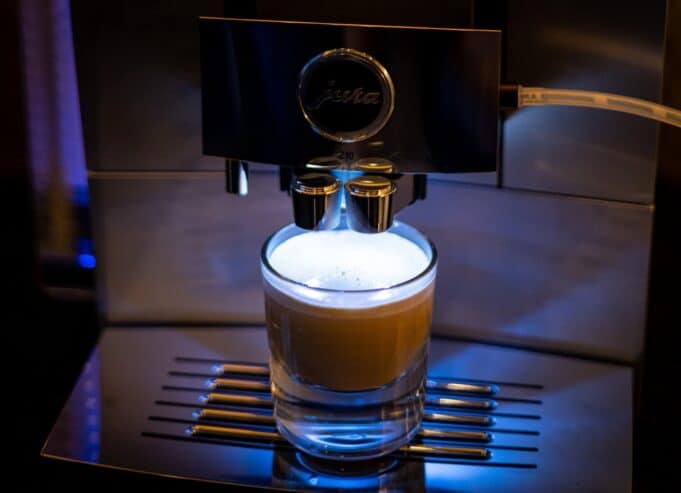The promise of a Super-Automatic espresso machine is simple: you get Café quality espresso drinks at the touch of a button. Because beans are ground on demand you get a fresh cup every time when you want it. Pretty nice.
Bean-to-cup machines as some call them have been around for a while, so it’s no surprise that they continue to be popular with consumers who enjoy the morning convenience and want to avoid the hassles of doing all the grinding, tamping and brewing themselves. Many also turn to these machines — made by the likes of Philips/Saeco, Miele, Jura, DeLonghi — because they reduce the environmental impact produced by pod-based systems from Nespresso, Keurig, Illy, among others.
However, there’s yet another secret super-power that Super-Automatic espresso machines enjoy.
And that has to do with milk consumption.
They are very efficient when it comes to making milk-based espresso drinks such as Lattes and Cappuccinos, but especially shorter ones like Flat Whites and Cortados and Macchiatos.
Heres’ why.
Why are Super-Automatic Espresso Machines More Efficient When Making Milk-Based Drinks?
Making a Cortado With a Semi-Automatic Espresso Machine

Let’s first look at making, say, a Cortado using a traditional Semi-Automatic espresso machine. It could be any brand. Gaggia, ECM, Rancilio, La Marzocco, Breville, Rocket, Lelit. Doesn’t matter as the basic workflow for brewing espresso is the same across the board: grind approximately 18 grams of beans (for a double shot) and dose, tamp and then insert the portafilter and pull a shot yielding about 36 grams output in about 25-35 seconds for a standard extraction using medium/dark roast beans. The recipe is universal; though you can tweak to taste as desired.
After you have an espresso shot you need some steamed/frothed milk.
In the case of a Cortado it’s a short drink with a strong flavor profile because the espresso-to-milk ratio is much greater than a typical Starbucks Latte which is, by comparison, milkier.
Typically a Cortado is served with a 1:1 espresso-to-milk ratio. For a four ounce pour — which is often served in a lovely Gibraltar glass — that would mean 2 ounces of espresso and 2 ounces of steamed milk.
And here’s the rub.
It’s tricky to steam small quantities of milk. Most commonly a 10 or 12-ounce pitcher is used. In this case a 6 ounce pitcher might be a smart choice as you need only 2 ounces of milk to finish of the Cortado drink. However, even baristas know steaming in a small pitcher can be tricky. Even still, the best can do it. And, yet, there will still be milk wasted as you’ll need to fill almost the pitcher approximately 3 ounces, and that’s before it expands after steaming. True, there’s not too much waste in this case, but there’s still some — enough that if you’re brewing several Cortados throughout the day the milk wastage will add up. It gets worse if you need to use a 10 ounce pitcher which will require more milk and result in even more waste.
In the end if you’re making short milk-based espressos like Flat Whites and Cortados you will end up using more milk than you will need to finish the beverage. Of course one solution is to make two drinks so that you can apply the extra milk to the second. This is workable when you need to do so, but for single drinks it still doesn’t solve the problem.
With a Macchiato the issue is magnified further. The Macchiato is basically an straight espresso shot with a dash of milk. Because it requires just a bit of milk — even less than a Cortado or Flat White — there’s tremendous inefficiency in steaming a small pitcher merely to put a small spoonful of milk on top.
Making a Cortado With a Super-Automatic Espresso Machine

Okay, then, so what’s the secret weapon that a Super-Automatic espresso machine brings to the table when it comes to milk efficiency?
Again, let’s use the Cortado as a baseline. And, given we recently reviewed the mighty and superb Jura Z10 on Stark Insider we’ll use that as an, albeit pricey, example for the machine. Again, other models by Philips, DeLonghi, and Breville will also feature this inherit advantage.
Workflow in this case it much simpler. After powering on the Jura and waiting for the rinse cycle to finish you place a Gibraltar under the spout and select Cortado and dial in any preferences. Ensure you have a milk container connected via a hose and then push start. The machines does the rest: automatically grinding beans, tamping a puck and brewing the drink.
With the Jura the espresso is brewed first. And, then, a small quantity of beautifully steamed milk is added on top.
Here, the Super-Automatic has an advantage over traditional milk steaming methods.
RELATED
Best espresso machines under $1,000 for beginners and aspiring home baristas
That’s because it draws precisely the amount of milk needed to make any beverage. There’s virtually no waste. Compare that to steaming traditionally in a pitcher and you’ll quickly realize this is a pretty nifty — and underreported advantage — of these kinds of automatic wonders.
In any case this is just my perspective and experience of working across these various types of espresso machines. I still prefer the joy of manually whipping up a Cortado on a traditional machine. But I know there’s going to be some amount of milk wasted when making short milk drinks. The same is not true when it comes to the Jura in this example. The Z10 (or E6, E8, Ena, etc.) will draw only the milk needed from the container. You can then put that milk container back into the fridge and store it until it’s next needed — with almost no waste.
I’d have to say this is super slick and of particular note to those who like to maximize milk efficiency!

